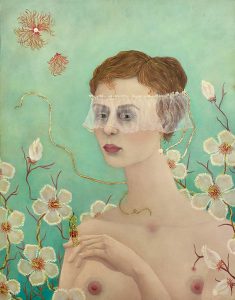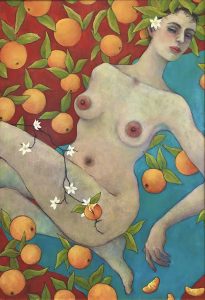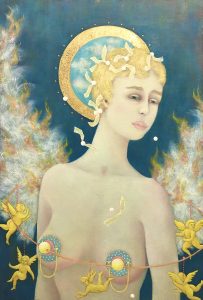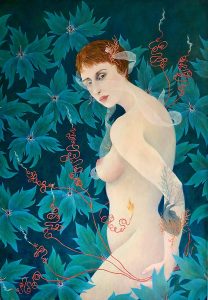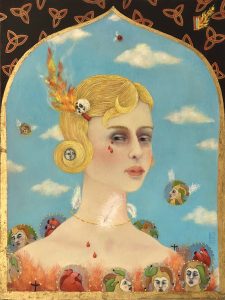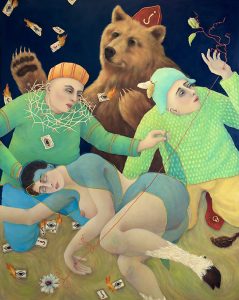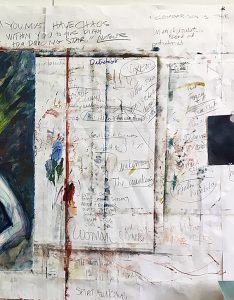
Rachel Romano, Sweet Pulp, oil on paper, 127cmx96cm (all rights reserved. Reproduction prohibited).
Rachel Romano, in her own words / Rachel Romano, attraverso le sue parole
Compiled by Pamela Goldman /a cura di Pamela Goldman (the translation into Italian at the bottom of the page)
My connection to art begin at age 7 with regular sojourns with my father to the Metropolitan Museum of Art. After a train ride from Connecticut he would be waiting at arrivals to whisk me off through the streets of New York. These were magical, mysterious, and wondrous years. My father was a poet, actor, and original thespian of Greenwich Village. He planted the seeds of storytelling.

Expecting to go to art school, my very brief encounter was cut short by unforeseen family circumstances. Fast forward through years of work in advertising, architecture, landscaping, and motherhood; 39 years later my painting career began. At age 38, I did attempt another go at art school at the Lyme Academy of Fine Art, but having a two year old son made me look at life choices. I wanted to be selfish about my art, and selfish about raising my son. Both couldn’t happen, so motherhood became the focus. That year of art school did inform me about my art, and ultimately help lead me to where I am today.
Early 2015, my art career finally began (late bloomer), after taking numerous workshops with Tim Hawkesworth in 2014. No painting was taught, it was all about self discovery, and what a wild ride it was. The first 5 day workshop I churned out 56 large rough drawings and paintings. The flood gates had opened. I discovered that I was a storyteller for adults. So much to say, yet still so little direction. The focus of my art began to take shape; exploring the how, the why of what one feels and experiences, and finding strength through change and adversity. I became a symbolic/allegorical figure painter. I find inspiration in personal myths, and the stories of others. The laughter, love, and sorrow of our lives fills my creative well. It is in this connection to one’s heart that brings the richness of story out in my work.
My process begins with a very rough drawing/scribble in my sketchbook: which I then will translate to a large canvas. I work from memory, my imagination, thinking and feeling through the expression of what I am trying to conceive. I find if I work from a model, it is too informed, it creates too much reality in the figure. It’s a completely different process. I paint mostly large canvases and drawings. My paintings usually take 2-3 months to complete, and I work on several paintings at a time, to give breathing room, and not to become too precious. Many times I will paint out, or radically change an image if it is not working, even cut a part of a painting. It is important to be fearless. Lately, I have been doing very small drawings for a broader audience. Not sure if I like this, sometimes it feels too much like an assembly line. I find it difficult to translate my larger works to a small size. I have to approach the small works very differently, simplify, yet still get the idea across.

My finished paintings are very much like the painters of the Northern Renaissance. I love working in oils because it has so much forgiveness, wiping out, adding new layers. Lots of vigor goes into the initial layout. Nothing is really worked out before I start a painting, consequently my paintings will go through many iterations before they are complete. As I resolve a painting, then the more precise glazed layers are applied. Some disagree with this approach, thinking I should have planned more out. But for me, that initial energy of scribbling is what gets me going, thinking by doing. It is almost like there are two sides to me as an artist. A more abstracted side, and then the much more refined side. Sometimes I feel the pressure, not necessarily the desire, to let the wilder side be predominant. But I always return to who I am instinctively. When I see a Van Eyck or Madonna painting, my soul sings. So be it!
I am drawn to all forms of art, there is so much out there that can inform you in your process. On the other hand, looking at too much art is detrimental, for me at least. I find I can overly compare myself to others, and it shuts down my creative process. I love and hate social media for this! So for me, it’s all about finding the balance, and still staying connected.
You can find me nearly every day in my studio, outside of Philadelphia, except when I am gallivanting about Europe, at residencies or shows. And, gratefully, I have numerous collectors around the globe to help me continue with my painting and travels.
The last year and half was extremely challenging to reconnect with humanity, and how that affected my painting. Having relocated my home, and moving my studio just as the pandemic was happening; I found myself sitting isolated in my living room feeling as if creativity had left me. I thought my well of imagery, and desire had dried up. I am not adverse to working in solitude, but the forced isolation was as if a limb had been cut off, I felt it, but it didn’t exist anymore. The fear of not knowing if one could regain and reconnect with art-making in some way, was paralyzing.
As I sat there for many months, not seeing people, contemplating how I would work in my new studio space being much smaller, I realized that I needed to let this time just happen. I gave into the not doing, and the percolating began. Things started to take shape as I crept back out into the world after lockdown. However, my connections to people had changed by the masking, and imposed socializing rules. The watching, the listening to, and catching the subtitles is what informs me, was now gone. Our new paradigm changed my access to the greater world. I feel as a result we have become somewhat generic, even invisible. How was I to find my connection with humans and story. And then, the re-entry/relearning process slowly emerged.
My passion for painting comes deeply from encounters and my interactions with people, as I move through society watching/listening. The feeling world plays a huge role in my creative process and germinating ideas. Previously life was fluid, moving freely, watching everything. I had a sanguine approach, flitting about, catching tidbits, taking so many mental notes. Today, because of extreme differences many of us are divided. The harsh political climate, and Covid realities have changed how I am able to access stories for my paintings. Yes i can get everything from the news, but it is being with humans, out in the world that fills my creative well. Now there are mini moments, and I have to make them count. Looking deeper, feeling deeper, has helped me rediscover my creativity.

Painting for me is as natural as living and breathing. It lets me transcend the pain and suffering of every day, by drawing on my experiences, or experience of others, and releasing them onto canvas. There is inspiration in the everyday, if we take the time to look, hear, and feel. Our days are filled with constant imagery and happenings. Watching society move through a daily rhythm one encounters all sorts of narratives. My aim is to create a visual story filled with dreamlike imagery, in many instances not making immediate sense. Many of my works are symbolic allegories on judgement or prejudices of others (see Palm Reader Parable). She is adored, they are her protectors from judgement, and yet there are still so many questions. The bear is their moral, spiritual support. He’s the healer, full of strength and wisdom. A story can be created simply seeing a shell on a forest floor, and wondering how it came to be there, or to passing by an elderly woman sitting on a bench, groomed to perfection, but a bit tattered, and far away look. What is she reminiscing on or wishing for? Other times my own history or mythology/belief system will help create the story, and it’s expanded upon in a symbolic way. For example: recalling a moment in time it wouldn’t consist as an identifiable composition such as a mother sitting on a sofa nursing a child, (see painting Complexities of Motherhood) instead it consists of symbolism beyond the act of nursing. Motherhood is forever, never disconnected, full of wisdom, sadness, strength and power.
The creative process begins with images swirling in my head, many times late at night in bed, or in the shower. I think many can relate to moments like these. My mind quiets from the peripheral noise, and I am much more in tune with my deeper thinking, and my subconscious realm touches my consciousness. My artwork is about drawing you in and creating your own narrative, and opening up your imagination to what it is or what could be, for you to create your own story by connecting with the figures and objects. I am drawn to imagery that has mystery, Northern Renaissance Art makes my soul sing. My paintings have a fictionalized veil on reality, with seemingly frivolous objects that connect dots to a deeper meaning. We already experience so much reality, through the Internet, social media, phones, televisions, it’s important to me for my art to be playful, and mysterious. Looking at my work I want one to travel, be taken away, I think many of us want to get away from the everyday, and where one can experience their own imaginary realm, yet stay grounded within reality.
When I set out to create work, there are times it’s just an inspirational moment. It’s not deeply thought out, but from images and words swirling in my head. I then scribble onto a canvas, and sometimes will make a small simple sketch, but not often. When I have my works up on the board I’m looking at the moving structures across the different canvases. Words fill my brain continually, and bring the images more meaning, helping me to find what I’m trying to say. To keep my flow going I will write words on my wall, (see photo of wall writing) phrases anything to clear the brain to let in more, giving me freedom to think broadly about the painting. My paintings are comprised of many layers, working on several canvases at once so as not to get too fixated on perfection in the early stages. I have killed many a painting that way. I have them lined up on easels, on the wall, and move back and forth fluidly, letting them rest. I then stand back and look at how they flow with each other. If a painting is not working at any stage, i will wipe it, or change the composition/color drastically. It is important to be fearless. I know some artist believe that you need to have a full worked out sketch, for me it actually kills the creative moment. If it is too worked out to start I’ll just leave it as a drawing and move on. I am a goal oriented person, and to do things over and over again stifles me. GroundHog Day makes me crazy! However, I do admire artists who can really dissect and look at an object and paint it over and over again to really experience the seeing of that object.
When I am painting for an exhibition I don’t paint similar imagery for each work. The stories, and the content and color themes tend to be disparate. I paint what comes into my head. Collectively they look like my work but that is where the similarity ends. They all are individual, and stand on their own, and that is different from many artists who do a series. I haven’t really figured out how to approach a series, my mind doesn’t work that way. Looking at art whether it’s abstract, traditional forms of landscape, still life or portraiture; I want to be drawn in and create a narrative. A good painting has that effect, complex or simple.
I am mostly self-taught, and every day I discover something new in my art making process. There are moments when I wish I had more available time for education, but maybe I’m romanticizing the idea of education. I am a person that loves to research, experience and learn, so it’s a quandary. In the end, time is limited and I need to just be doing.
*°*°*
Traduzione in italiano
di Simona Maria Frigerio
Il mio rapporto con l’arte ha avuto inizio all’età di sette anni con visite regolari, accompagnata da mio padre, al Metropolitan Museum of Art. Dopo il tragitto in treno dal Connecticut, mi attendeva agli arrivi per condurmi lungo le strade di New York. Quelli erano anno magici, misteriosi e straordinari. Mio padre era poeta, attore e teatrante al Greenwich Village. Ha piantato in me i semi della narrazione.
Allora pensavo di frequentare una scuola d’arte ma questo breve idillio è stato stroncato da circostanze familiari impreviste. A questo punto occorre fare un balzo in avanti di 39 anni – successivo al lavoro in campo pubblicitario, in architettura, architettura del paesaggio e alla mia maternità – perché la mia carriera come pittrice abbia inizio. All’età di 38 anni, in realtà, avevo già tentato la strada della scuola d’arte – iscrivendomi alla Lyme Academy of Fine Art, ma avendo un bambino di due anni da curare, la vita decise altrimenti. Ero egoista nell’arte come riguardo al crescere mio figlio. Non potevo avere entrambi, quindi mi concentrai sulla maternità. Ma quell’anno alla Lyme mi rese cosciente del mio modo di fare arte, e alla fine mi è stato utile per diventare ciò che sono.
All’inizio del 2015, la mia carriera artistica ha finalmente avito inizio (una tardiva maturazione, la mia), dopo aver frequentato diversi workshop con Tim Hawkesworth nel 2014. Non mi è stato insegnato a dipingere, bensì a scoprire me stessa e la mia folle corsa. Nei primi cinque giorni di workshop ho sfornato 56 tra dipinti e schizzi di grandi dimensioni. Le acque si erano finalmente smosse ed ero un torrente in piena. Compresi di essere una narratrice per adulti. Così tanto da dire, ma ben poche indicazioni. L’obiettivo del mio fare arte ha cominciato a prendere forma; esplorando il come e il perché di ciò che si sente e sperimenta, trovando la forza attraverso il cambiamento e le avversità. Sono diventata una pittrice di figure simboliche/allegoriche. Ho trovato ispirazione nei miti personali e nelle storie altrui. Il riso, l’amore e la tristezza delle nostre vite alimentano la mia vena creativa. È il legame con il cuore umano che porta alla luce, nel mio lavoro, la ricchezza di una storia.
Il processo creativo parte con uno schizzo nell’album che, poi, trasferisco su tele di grandi dimensioni. Lavoro a memoria, attraverso la mia immaginazione, pensando e sentendo l’espressione di ciò che sto tentando di concepire. Se lavorassi con un modello, il tutto diventerebbe troppo consapevole, la realtà prenderebbe il sopravvento nella figurazione. Il mio è un processo completamente diverso. Dipingo principalmente tele di grandi dimensioni e disegno. I dipinti necessitano di 2-3 mesi per essere completati, e lavoro contemporaneamente su più tele, per darmi agio e non diventare troppo perfezionista. Molte volte cancello o cambio radicalmente l’immagine se non funziona, taglio via persino una parte del dipinto. Non bisogna avere paura. Ultimamente, ho iniziato a fare piccoli disegni per un pubblico più vasto. Non sono certa che mi piaccia – a volte mi sembra di lavorare alla catena di montaggio. Trovo difficile traslare i miei lavori di grandi dimensioni in piccoli formati. Devo approcciarmi a questi ultimi diversamente, semplificare riuscendo, comunque, a trasmettere la mia idea.

I miei quadri rimandano a quelli del Rinascimento Nordico. Amo lavorare con la pittura a olio perché ‘perdona’, permette di cancellare e di aggiungere strati. All’inizio implica un certo vigore. Niente è davvero risolto prima che inizi a dipingere, di conseguenza i miei quadri passano attraverso varie versioni prima di essere completati. Solo quando considero l’opera completata, applico gli strani finali più precisi che danno l’apparenza dell’invetriato. Alcuni non sono d’accordo con il mio approccio al lavoro, pensano che dovrei pianificarlo meglio. Ma per me, l’energia che infondo nel primo schizzo è ciò che mi accende – pensare facendo. È come se esistessero due personalità che compongono, in me, l’artista. Un lato più astratto e, poi, quello maggiormente raffinato. A volte sento il carico, non necessariamente il desiderio, che il mio lato selvaggio predomini. Ma torno sempre a ciò che sono istintivamente. Quando ammiro un Van Eyck o una Madonna, la mia anima ne gode. E così deve essere!
Sono attratta da ogni forma d’arte: ci sono così tanti stimoli che possono contribuire al processo creativo. Dall’altro lato, vedere troppa arte può essere negativo – almeno per me. Posso fare troppi confronti tra me a gli altri artisti e questo mi blocca. Amo e, contemporaneamente, odio i social per la medesima ragione! Per quanto mi riguarda, bisogna trovare un equilibrio e, nel contempo, restare connessi.
Mi si può trovare quasi ogni giorno in studio, fuori Philadelphia, eccetto quando gironzolo per l’Europa, sono in residenza o alle mostre. E fortunatamente ho diversi collezionisti in giro per il mondo che sostengono il mio lavoro e i miei viaggi.
L’ultimo anno e mezzo è stato estremamente complicato rimanere in contatto con gli altri esseri umani, e la mia pittura ne ha risentito. Essendomi trasferita a livello abitativo e avendo altresì traslocato lo studio nel momento in cui esplodeva la pandemia, mi sono ritrovata seduta, da sola, nel mio salotto sentendomi come se la creatività mi avesse abbandonata. Pensavo che il mio immaginario e il desiderio si fossero prosciugati. Non sono contraria al lavoro in solitudine ma l’isolamento forzato è stato come ritrovarsi in un limbo, tagliati fuori. Il timore di non sapere se mi sarei rimessa al lavoro mi paralizzava.
Sono rimasta così per molti mesi, non vedendo nessuno, meditando su come avrei potuto lavorare nel mio nuovo studio, molto più piccolo, e ho compreso che dovevo lasciare che le cose accadessero. Ho ceduto: non facevo più nulla, ma qualcosa lentamente ha cominciato a smuoversi. Le cose hanno preso nuovamente forma mentre mi riaffacciavo al mondo dopo il lockdown. In ogni modo, le mie relazioni con le persone erano cambiate a causa delle mascherine e delle regole sociali imposte. La vista, l’ascolto, il cogliere le sottigliezze: era tutto andato! Il nostro nuovo modello di vita mi impediva di avere accesso al resto del mondo. Come conseguenza penso che siamo diventati in qualche modo tutti interscambiabili, persino invisibili. Come potevo ritrovare i miei legami con l’umanità e la storia, mi chiedevo. Ed è stato allora che il processo di rientro/riapprendimento ha iniziato a delinearsi, lentamente.
La mia passione per la pittura proviene dai miei incontri e dalle interazioni con le persone, mentre mi muovo in società guardando/ascoltando gli altri. Ho la sensazione che il mondo giochi un ruolo importante nel processo creativo e nel far germogliare nuove idee. La vita, prima, era fluida, ci si muoveva liberamente, potevi osservare qualsiasi cosa. Avevo un approccio ottimista, svolazzando ovunque, afferrando chicche, prendendo tantissimi appunti mentali. Oggigiorno, a causa del differente modo di sentire, siamo divisi. L’aspro clima politico e la realtà del Covid hanno cambiato la maniera in cui accedo alle storie – che sono la base del mio fare arte. Certo, posso informarmi con i telegiornali, ma è stando in mezzo agli esseri umani, là fuori nel mondo, che alimento la mia vena creativa. Adesso ci sono brevi attimi, e devo centellinarli. Guardare e sentire più profondamente mi ha aiutata a riscoprire la creatività.
Dipingere, per me, è naturale come vivere o respirare. Mi permette di trascendere il dolore e le sofferenze di ogni giorno, disegnando le mie esperienze o quelle di altri, per poi consegnarle alla tela. Si può trovare ispirazione anche nelle piccole faccende quotidiane – se ci prendiamo il tempo di guardare, ascoltare e sentire. Le nostre giornate sono costellate di immagini ed eventi. Guardando la società muoversi seguendo il proprio ritmo, si scopre ogni sorta di narrazione. Il mio scopo è creare una storia visiva intessuta di immagini oniriche – in molti casi non cercando un significato immediato. Molti tra i miei lavori sono simbolici, allegorie sui giudizi e pregiudizi altrui (guardate una tra le mie opere, Palm Reader Parable). La figura femminile è adorata, la proteggono dal giudizio, eppure ci sono domande senza risposta. L’orso è il supporto morale e spirituale. È il guaritore, pieno di forza e saggezza. Si può creare una storia semplicemente osservando una conchiglia nel sottobosco e meravigliandosi di come sia potuta arrivate lì; oppure, passando accanto a un’anziana seduta su una panchina, curata perfettamente, ma un po’ spiegazzata e con uno sguardo distante, ci si può domandare cosa stia rammentando o desiderando. In altri tempi, il mio sistema di creare storie o miti/credi mi aiutava a formulare una narrazione, che poi si approfondiva di contenuti simbolici. Per esempio: ricordare un momento preciso non consisterebbe nella composizione identificabile come una madre seduta su un divano che dà da mangiare a un bambino (basti vedere Complexities of Motherhood), bensì in un’immagine simbolica che va aldilà dell’atto di nutrire. La maternità è per sempre, mai separata, piena di saggezza, tristezza, forza e potere.
Il processo creativo, quindi, inizia con le immagini che mi frullano nella mente, molte volte quando sono a letto a tarda notte, o nella doccia. Penso che in molti sperimentino la stessa sensazione. La mia mente si stacca dal rumore di sottofondo, ed entro in contatto con i miei pensieri e il mio subconscio, a sua volta, con la coscienza. Il mio lavoro consiste nel catturarti e raccontare la tua storia, aprire la tua immaginazione a ciò che è o potrebbe essere, così che tu possa creare la tua storia entrando in contatto con oggetti e personaggi. Sono attratta dall’immaginazione e dal mistero, per questo l’arte rinascimentale nordica mi è affine. I miei quadri stendono un velo fittizio sulla realtà, grazie a oggetti apparentemente frivoli che connettono ‘i puntini’ a un significato più profondo. Sperimentiamo già abbastanza realtà attraverso internet, i social, via telefono, la televisione: per me, è importante che la mia arte sua giocosa e, nel contempo, misteriosa. Quando qualcuno osserva un mio quadro vorrei che viaggiasse, si sentisse trasportato altrove: penso che molti tra di noi vogliano evadere dalla quotidianità, e dove si può fare esperienza del proprio immaginario stando comunque con i piedi piantati per terra?
Quando mi metto al lavoro, a volte mi sento ispirata. Non ho tutto chiaro nella mia testa in quanto immagini e parole mi frullano nella mente. A questo punto inizio a schizzare la tela, e qualche volta è un piccolo bozzetto, ma non spesso. Quando osservo i miei lavori, li confronto e osservo le strutture emozionali che li compongono. Le parole si affastellano nel mio cervello continuamente, e danno maggiore significato alle immagini, aiutandomi a capire cosa cerco di esprimere. Per mantenere il flusso, scrivo le parole sui muri [potete vederle in un’immagine della galleria fotografica, n.d.t.], esprimo qualsiasi cosa per schiarirmi la mente e permettermi di aggiungerne altre, così da concedermi di pensare ancora più liberamente. I miei quadri sono composti da più strati: come ho già detto, lavoro su più tele contemporaneamente così da evitare di perseguire la perfezione nei primi stadi. Ho rovinato un sacco di opere in quel modo. Li allineo sui cavalletti, sul muro, e mi muovo tra loro in maniera fluida, lasciandoli riposare. Poi faccio un passo indietro e osservo come si rapportano tra loro. Se un quadro non funziona, lo cancello o modifico la composizione o il colore – anche drasticamente. Come ho già affermato, mai avere paura. So che molti artisti preferiscono avere disegni di base precisi; ma, nel mio caso, tutto ciò rovinerebbe il momento creativo. Se lo schizzo è troppo definito, preferisco conservarlo come disegno e passare ad altro. Sono una persona orientata verso un obiettivo, e fare e rifare le stesse cose mi soffoca. GroundHog Day [il film Ricomincio da capo, in cui una giornata continua a ripetersi incessantemente per un presentatore televisivo, n.d.t.] mi fa impazzire! In ogni caso, ammiro gli artisti che dissezionano un oggetto e lo dipingono più e più volte fino a sperimentare ogni visuale dello stesso.
Quando dipingo per una mostra, non dipingo le medesime immagini. Le storie, i contenuti e i colori tendono a essere disparati. Dipingo ciò che mi viene in mente. Collettivamente si capisce che sono tutti miei lavori ma la somiglianza finisce lì. Ognuno è a sé – e questo è diverso da quanto fanno altri artisti che dipingono in serie. Non capisco come potrei dedicarmi a una serie: la mia mente non ragiona in quel modo. Quando guardo le opere d’arte – che siano astratte, tradizionali, paesaggi, nature morte o ritratti, voglio essere catturata e inventare una mia narrazione. Un buon dipinto fa quell’effetto – che sia semplice o complesso poco importa.
Sono un’autodidatta, e ogni giorno scopro qualcosa di nuovo nel mio processo creativo. Ci sono momenti in cui vorrei avere più tempo per istruirmi, ma forse coltivo un’idea romantica dell’educazione. Sono una persona che ama la ricerca, l’esperienza e apprendere, perciò è problematico per me. Alla fin fine, il tempo è limitato e io sento il bisogno di fare.
Friday, December 31, 2021 – Special Issue / Venerdì, 31 dicembre 2021 – Numero Speciale
On the cover and in the article: paintings by Rachel Romano (photos compiled by Pamela Goldman / photo gallery & layout by Lucia Mazzilli). Courtesy by the Artist (all rights reserved. Reproduction prohibited).
In copertina e nel pezzo: quadri di Rachel Romano (foto a cura di Pamela Goldman / galleria fotografica e layout a cura di Lucia Mazzilli). Courtesy l’Artista (tutti i diritti riservati. Vietata la riproduzione).
Photo gallery:
1) Love potion, oil on linen on panel, 71cmx50cm;
2) Sweet Pulp, oil on paper, 127cmx96cm;
3) Complexities of Motherhood, oil on linen on panel, 87cmx 59cm;
4) Psyche’s Heart, oil on linen, 102cmx71cm;
5) Nickel Fate, oil on linen on panel, 59cmx46cm;
6) Palm Reader Parable, oil on birch panel, 152cmx122cm;
7) Wall of words;
8) Studio shot;
9) Studio shot;
10) Studio – work in progress.








